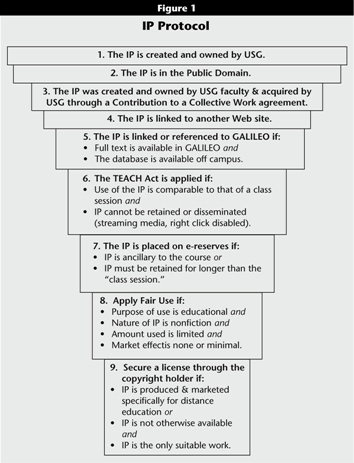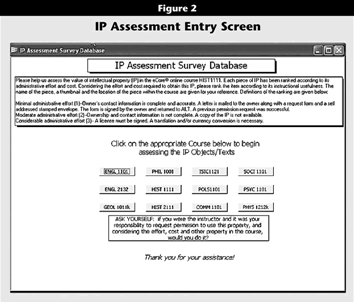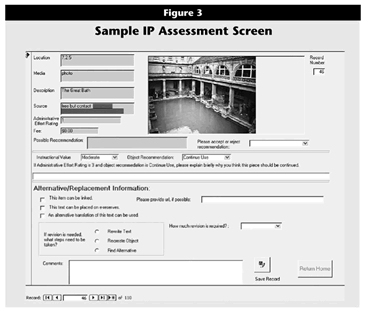Managing permissions for hundreds of pieces of intellectual property (IP) can be a daunting task for any course, but it is vital in distance learning courses because of legal implications specific to the online environment. In 1998, the Digital Millennium Copyright Act (DMCA)1 severely limited the use of copyrighted materials in distance learning. In 2002, the Technology, Education, and Copyright Harmonization Act (TEACH Act)2 relaxed these restrictions under specific conditions. These two laws significantly changed the way educators could use copyrighted material in the digital classroom. Ensuring the timely renewal of permissions and up-to-date IP records may require limiting the use of IP from external sources. How can a university or system do this without compromising instructional integrity?
Advanced Learning Technologies (ALT), a unit of the Board of Regents of the University System of Georgia (USG), had to do just that while developing the eCore,3 a set of 25 online courses comprising the first two years of an undergraduate degree. The eCore is administered as a system collaborative program. Students are registered and receive credits through six affiliated USG institutions.
The eCore courses are developed by collaborative teams of faculty from various USG institutions, instructional designers from ALT, and programmers from the University of Georgia. The eCore project manager oversees the course development process, and a separate IP manager handles IP issues.
While most eCore content is original material developed specifically for each course, course developers want the freedom to incorporate exemplary external IP as well. Unfortunately, budget cuts have limited not only the fees the university system can pay for IP incorporated into eCore courses but also the staff available to manage permission requests. ALT clearly needed an efficient system for assessing external IP without compromising instructional integrity. Ultimately, ALT decided on a range of procedures and options, including the following:
- Establish a protocol emphasizing a preference for original over non-original content.
- Train instructional designers and faculty developers to understand the protocol.
- Assign status to determine where a specific piece of IP falls within the protocol.
- Assess the specific IP to determine—given the cost and administrative effort involved in obtaining permission to use it—the significance of the work’s contribution to the course.
Establish a Protocol
The ALT protocol appears in Figure 1. The concept resembles an inverse pyramid, with the largest amount of course content falling within the higher tiers and fewer pieces of content, including external IP, represented below. The following explanation of the various protocol levels parallels the steps in the figure:

Click image for larger view.
1. The first preference is always for original content created and owned by the USG. Subsequent priorities set for course content minimize problems with copyright ownership and usage, licensing costs, and administrative time and effort required to handle the IP.
2. Although determining if a piece of IP lies in the public domain can be time consuming, many resources can assist with that determination, such as Laura Gassaway’s Web site at the University of North Carolina.4 The advantage of using IP in the public domain is that once that determination is made and documented, no subsequent effort is needed. A piece of IP in the public domain usually remains there.
3. A Contribution to a Collective Work agreement allows the USG to use the contribution at no cost, indefinitely, while the copyright owner retains all rights. Most of these legal agreements are signed by members of the course development team, but occasionally another USG faculty member contributes material in this way.
4. If the piece of IP is available through a reliable and stable Web site, a link is added to the course rather than copying the work and placing it in the course.
5. The USG’s online library, GALILEO, provides databases including full-text versions of certain articles and images. Since all eCore courses are delivered online, any IP from GALILEO must be from databases licensed for off-campus use.
6. Applying the TEACH Act5 involves posting a Notice to Students at the front of the course and disabling right-clicking on pages where the IP appears, thus disabling the ability to make local copies. It also involves providing a copyright policy and training to the campus community. Although the USG already had a copyright policy, both the policy and training needed updating.
7. ALT decided not to use the e-reserve option on a program-wide basis because placing IP on e-reserve requires the same level of permission as placing it in a course. The e-reserve option would actually complicate IP management because eCore courses are delivered through several different institutions. Instructors of individual sections may add material to an e-reserve if they choose.
8. A Fair Use Assessment is written for each piece of IP assigned fair use status. A form incorporating the four factors of fair use presents the argument for each factor as it applies to the IP within a specific course. This Fair Use Assessment provides a record of the arguments for fair use for the benefit of any future IP manager or in the event of an inquiry.
9. The few remaining pieces of IP that require a license are researched to determine, as closely as possible, the copyright holder. Then a letter is mailed to the copyright holder including a permission form requesting the addressee to sign and return the form or forward the request to the rightful copyright owner. To limit the number of renewals, all requests ask for permission to use the IP for the “life of the course.” If the copyright owner rejects those terms, ALT negotiates for the maximum term possible. Some publishers, libraries, and museums require a formal signed license. A license may also be required when purchasing a CD or service granting the right to incorporate images and other IP in projects.
Train Users
The success of the IP protocol hinges on training the instructional designers and faculty developers on the necessity for following it. Instructional designers—the liaison between faculty developers and the IP manager—often make course modifications stipulated by a license and so must understand the protocol fully. The training does not discourage submission of non-original IP; it encourages consideration of many options and understanding of the limitations related to time, budget, and owner prerogative.
In the interest of time, the IP manager must have complete source information at the outset. In cases where the instructor or developer has used a piece of IP in a previous course, he or she may have made an initial contact for permission to use the IP in that course. That permission would not necessarily carry over to the new course, but it could furnish a starting point for researching the IP. On the other hand, instructors and developers occasionally cannot locate or recall the original source of the IP, making it more difficult to locate the copyright owner.
ALT recognizes that some courses, such as physics or mathematics, use very few if any external pieces of IP, whereas courses such as history will typically require more. Most licensing costs are reasonable, and ALT’s budget for licensing external IP does not limit the amount of IP that can be used in each course. The eCore project manager determines if a cost is acceptable.
Owner prerogative is the most difficult concept to convey during training. Simply requesting permission does not mean it will be forthcoming. Owners have the prerogative to deny permission, which they sometimes, though rarely, assert. Some owners oppose any kind of Internet publication of their work even if password protected. Others may attach unrealistic conditions to their permission, such as exorbitant fees, the adoption of a certain textbook, or unreasonably lengthy disclaimers or acknowledgments.
Finally, the development team needs to understand a limitation faced by the USG that does not apply to most institutions. Licensing IP from publishers, libraries, and museums often requires a binding signature. Only the senior vice chancellor for Support Services is authorized to sign such a license for the USG. This process can take several weeks, making licensing on a semester basis unrealistic.
In addition to training the development team and instructional designers on the protocol, ALT needed to update system-wide training on copyright law in order to claim exemption from copyright infringement for certain IP under the TEACH Act. One of the requirements for exemption is that “the transmitting body … provides informational materials to faculty, students, and relevant staff members that accurately describe, and promote compliance with, the laws of the United States relating to copyright…”6 The USG already had extensive policies and publications relating to copyright, but they had not been updated since enactment of the TEACH Act.7 In 2004, the USG hired a consultant to deliver training through a Webcast to all 34 campuses as well as to assist with updating the USG copyright policy.
Assign Status
Each piece of IP created outside the course development process—either by someone outside of the USG or by a faculty developer prior to participating in the eCore project—receives a status corresponding to one of the protocols. Since USG ownership is covered under the eCore service level agreement with the faculty developers, all content developed by the course development team during the eCore project, including that which can stand independently of the course content—such as a chart, photo, or essay—has the status “USG created and owned.” Assigning a status helps document the research and determines which IP requires permission.
Assess the IP
The next step is to assess the value to the course of IP that requires permission. The criteria for accepting a piece of IP states that it must be essential to the pedagogy of the course—not merely to enhance the look of the course or for entertainment. ALT developed an assessment tool that asks a series of questions about each piece of IP in each course. The instructional designer assigned to a particular course fills in responses for the IP in that course. For each piece of IP, the IP manager places in the assessment tool a thumbnail image, a description, the source, its location in the course, its cost, and a ranking of the administrative effort required to secure permission. The IP manager assigns each piece of IP one of three ranks:
The designers complete the assessment as though they were personally responsible for securing permission, considering the cost and administrative effort and assessing the IP for its instructional contribution— Minimal, Moderate, or Considerable. The designer chooses one of the following courses of action:
In cases where there are clear alternatives that are cheaper, easier, or better, the assessment tool recommends a course of action, which the designer can accept or reject. If there is no known alternative to the requested IP, no recommendation is offered. The field is open to the instructional design team’s preferences or suggestions.
If the assessment tool ranks the administrative effort Considerable and the designer recommends continued use, the assessment tool asks for an explanation as a way of documenting the contribution’s value.
Next, the designer provides information on possible alternatives or replacements. Is it possible to link to the IP? If so, what is the URL? Can the piece of IP be placed on e-reserve? (Although this question was originally included in the assessment tool, the e-reserve option was later eliminated.) Can an alternative source be used? If revision of the course is needed to incorporate an alternative, what type of revision is needed—rewrite text, recreate the object, or find an alternative? How much revision is required—minimal, moderate, or considerable? Finally, the screen provides a box where the designer can leave comments.
After all the IP in a course is assessed, the IP manager and the eCore project manager review the results. IP recommended to be discontinued is deleted from the course. The IP manager attempts to acquire permission for all other IP. If the copyright owner denies permission, the object is deleted from the course and the instructional designer rewrites content if needed. If the owner cannot be found or does not respond to the request, the IP is either deleted or the TEACH Act is applied by providing a Notice to Students at the beginning of the course and disabling right mouse click on the page on which the IP appears. Frequently, substitutes are found to replace IP with problematic permission requirements. Very rarely are pieces of IP or content eliminated entirely as a result of the assessment.
Implementation
Implementation of the IP protocol and assessment project required minimal additional costs for the USG: a part-time IP manager, licensing fees, and, initially, a part-time student assistant to develop the assessment tool. Although hiring a dedicated IP manager may seem like a burdensome expense, centralized IP management for the extensive eCore program frees the course development teams to concentrate on course content. It also ensures a uniform process of requesting and documenting permissions, which makes retrieving information for renewals or inquiries time-efficient.
Licensing fees are leveraged by requesting the longest possible term of use. Although initial licensing costs are high, the cost per year drops, as does the cost of administering renewals. The cost of developing the assessment tool was leveraged by choosing a familiar application, Microsoft Access, for the tool environment. This meant that the tool could be developed in-house with student assistance in a matter of weeks. Additionally, the design of the tool uses a single entrance screen (see Figure 2) and individual screens (see the example in Figure 3) for each piece of IP, permitting expansion for any number of courses.

Click image for larger view.

Click image for larger view.
The initial stage, which included planning, establishing the protocol, creating a streamlined process, and building the assessment tool, took only five weeks for the two part-time staff members—a worthwhile investment for a system applied to 25 courses.
Benefits
Many benefits have followed implementation of the IP assessment protocol. Considerable time is saved on renewals by requesting life-of-course or extended terms of use, for example. Renewals plummeted from 191 in 2005 to 13 in 2006. Next year only eight pieces of IP will need renewal. Although the courses are revised regularly, rarely is new IP added after a course is completed, and so far the protocol has limited those additions to work that did not require permission. Unnecessary fees are saved by asking the development team to evaluate the IP chosen for a course. Fewer, more targeted pieces of IP are selected, making the courses more tightly constructed and easier to maintain.
Evaluation and assessment of IP add little time to the course development process. To aid in speedy evaluations, questions are limited to those required for making specific decisions. References and recommendations needed for quick, informed evaluations are provided within the assessment tool.
By far the greatest benefit of the assessment is the reduced number of licenses that must be escalated to the USG legal department for signatures. Now, almost all permissions can be managed at a lower level. A less tangible benefit is the sense of security from knowing that the protocol and assessment provide a framework for applying copyright exemptions appropriately.
Lessons Learned
IP management must be an integral part of course development and revision, not an afterthought. This is perhaps the most comprehensive copyright lesson we learned during development of the eCore. Decisions made during the permission acquisition process arising from licensing costs, failure to obtain permission, or the availability of alternative pieces of IP may affect the course content. Additionally, copyright holders may require attribution lines different from the ones in the course, necessitating a revision of one or more pages. If a piece of IP is deleted or an alternative is used, the content may need to be reworded. If permission is denied, a lesson may have to be entirely rewritten.
A protocol and assessment plan makes managing IP systematic and provides for reliable documentation. Successful assessment for a complex project like the eCore depends on a well-structured plan and clear lines of communication. Once those are in place, the benefits quickly become evident.
105_cong_public_laws&docid=f:publ304.105> (retrieved February 27, 2006).
107_cong_bills&docid=f:s487es.txt.pdf> (retrieved February 17, 2006).
